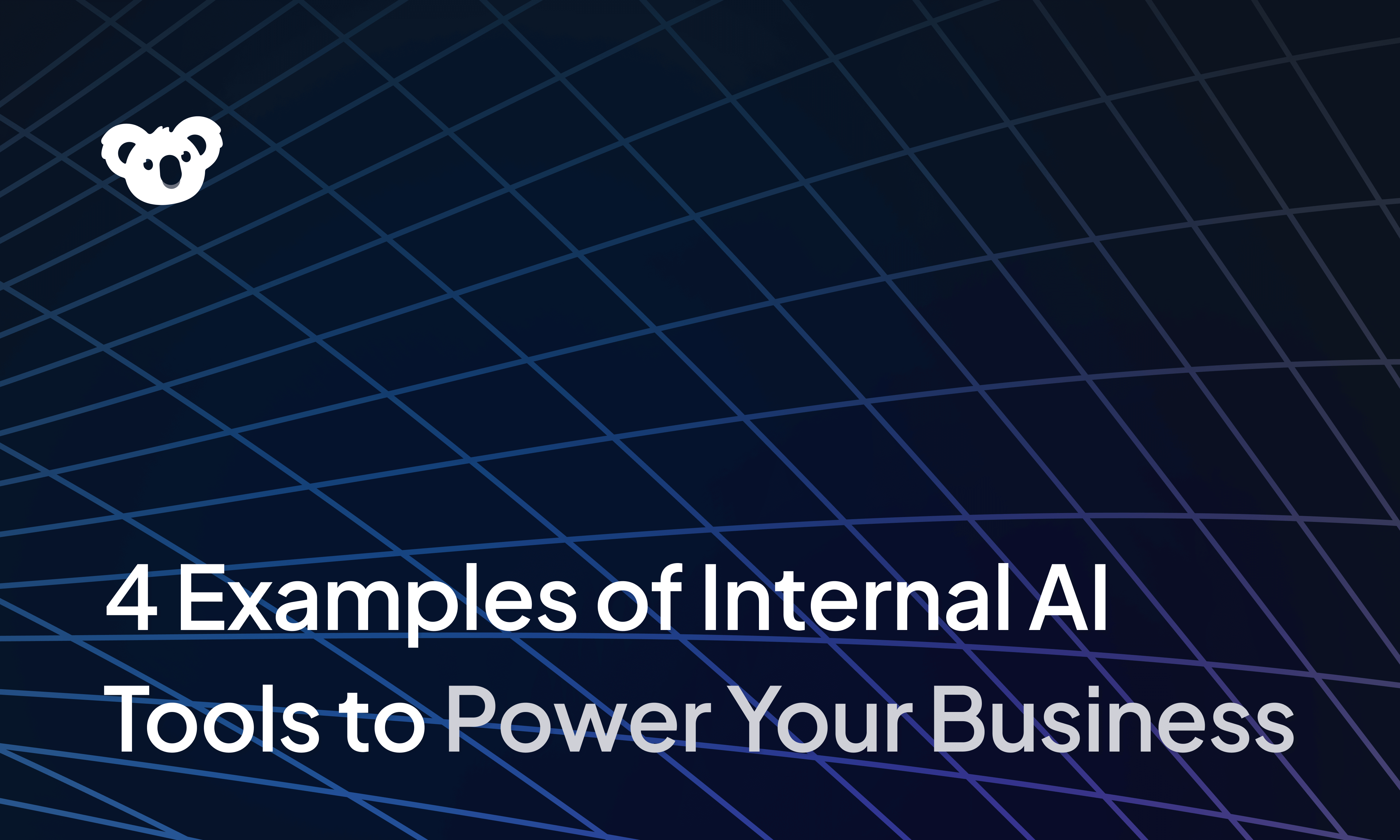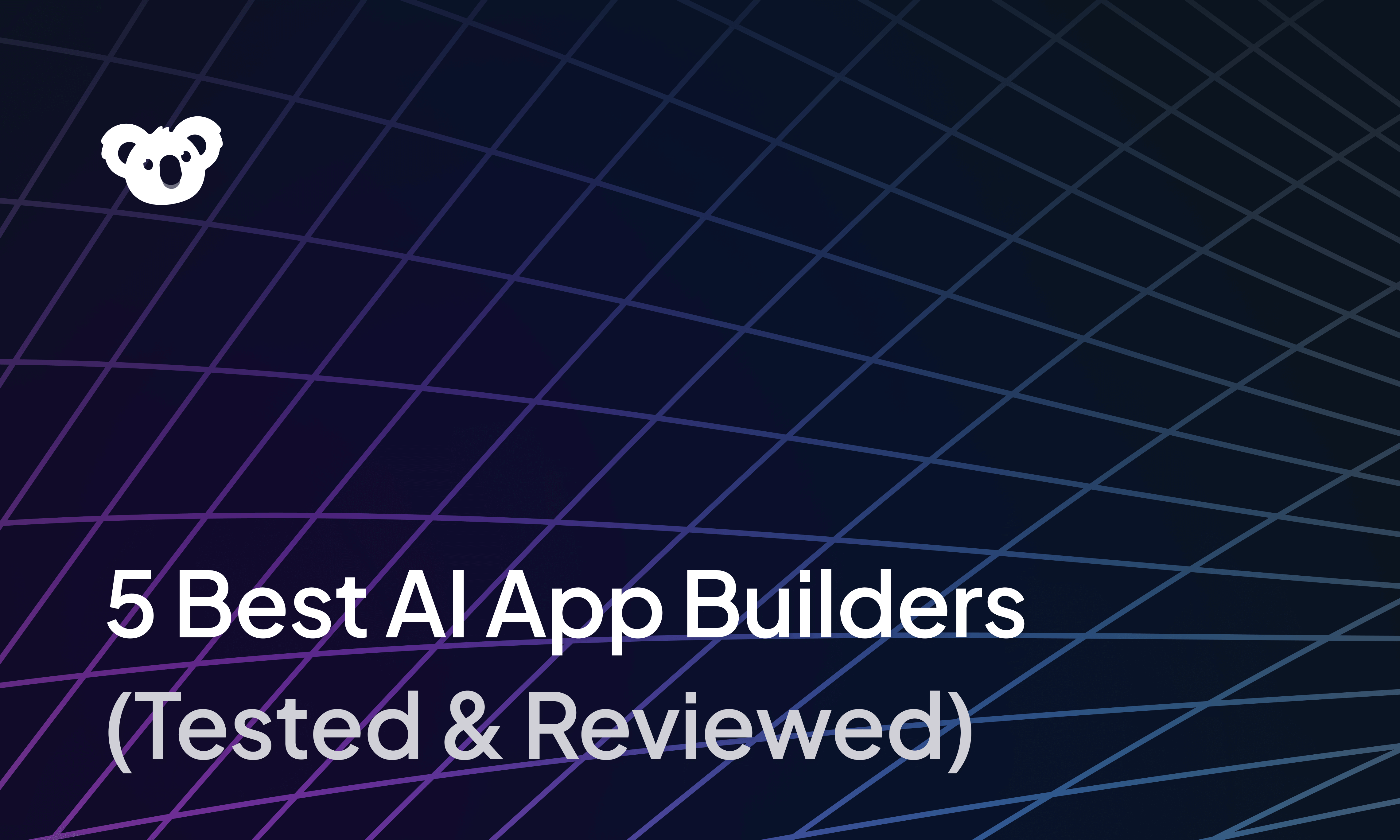


In 2025, finance process transformation tools like Vic.ai, Ramp, and EvenUp are helping teams replace brittle, rule-based workflows. These AI-first tools adapt to data, improve over time, and support better financial decisions.
In this article, we’ll cover:
- What finance process transformation actually looks like in 2025
- The essential strategy roadmap for finance modernization
- How Superblocks helps finance teams reduce friction and scale faster
Let’s start by defining what a finance process transformation is.
What is finance process transformation?
Finance process transformation is the redesign of core financial workflows using automation, integrated data, and AI. It improves how core tasks are executed, how data flows between systems, and how easily teams adapt as the business evolves.
The push towards transformation is driven by new expectations inside today’s businesses, including:
- Teams need real-time visibility to support decisions as they happen.
- Systems must support disruptions like market swings, supply chain shocks, or remote work.
- Finance leaders expect trust data to flow across ERPs, data warehouses, CRMs, and spreadsheets.
What’s the difference between digital transformation and finance process transformation?
Traditional digital transformation in finance typically centers around major ERP upgrades or the move to cloud-based systems. Finance process transformation is about agility, not just modernization.
It focuses on:
- Automating routine and judgment-based workflows using AI to classify data, flag exceptions, and handle approvals and reconciliations.
- Integrating and interpreting data from across the business to provide real-time visibility.
- Empowering finance teams to build their own tools using AI or low-code.
- Embedding finance processes into the core workflows of customer experience, operations, and HR functions.
Why finance teams are rethinking their operating model
Today’s business environment demands a finance function that drives strategic ambitions, provides real-time insights, and enables resilience across the enterprise. Yet many traditional finance operating models are not built to support this expanded role. To meet rising expectations, finance teams are rethinking how they operate.
Several drivers are fueling this change:
The need for trusted data and advanced analytics
Finance leaders want timely, accurate insights, but fragmented processes and inconsistent data often limit the quality and speed of reporting. Centralizing data models and integrating systems helps finance establish a single source of truth and improve data trust across the business.
Cross-functional finance partnerships
Leaders expect finance to act as a strategic partner that helps drive business performance. This requires deep collaboration with IT, operations, procurement, and other departments.
IT is essential for data integration, automation, and AI projects. Procurement and finance teams partnering enables real-time spend management and more agile sourcing decisions. Closer alignment with operations helps finance link financial outcomes to operational drivers.
Overall, these cross-functional partnerships ensure that finance processes and insights are embedded across the business.
The push for efficient growth
Finance teams are under pressure to support growth while controlling costs. That’s led many to explore new ways of working. Automation is playing a key role in this shift, by handling high-volume, repetitive tasks, so teams can focus on more strategic work without increasing headcount.
The acceleration of AI adoption
Many finance organizations are adapting their processes and structures to embed AI into routine workflows like forecasting and transaction processing. To make this work at scale, teams are introducing auditability, human-in-the-loop reviews, and risk flags to manage machine-led decision-making responsibly.
The shift toward a service-oriented finance team
As the role of finance evolves, business users expect more direct access to financial insights and processes. Finance teams are moving toward a service-oriented model to meet this expectation.
They are:
- Embedding financial controls and workflows into operational systems.
- Providing self-service dashboards for business partners.
- Designing processes that integrate seamlessly with day-to-day operations.
This shift makes finance more responsive, transparent, and aligned with business needs.
The 5 stages of a finance process transformation
Most successful transformations progress through a series of stages, though not always in a perfectly linear order. Teams often loop back or iterate, as new priorities emerge and technologies mature
Here are the key stages to include in a finance transformation roadmap:
1. Assessment & discovery
Transformation starts with understanding where the finance organization stands today.
This phase involves:
- Mapping existing processes
- Identifying pain points
- Analyzing tools and data flows
- Benchmarking performance against best practices
The outcome of this phase is a clear baseline and a set of targeted goals for improvement, whether that means increasing automation or improving data quality.
2. Design & alignment
The next step is to design the future-state processes and gain alignment across stakeholders.
This often involves:
- Reimagining workflows for automation and AI
- Mapping ideal data architectures
- Identifying the right technology stack to support transformation.
This is not a finance-only exercise. IT, operations, and procurement should be closely involved. Strong alignment at this stage ensures that new processes are both technically feasible and well-integrated with business needs. Many teams also establish governance structures here to guide the transformation.
3. Pilot & automate
Successful finance transformations rarely go “big bang.” Most start with high-impact, low-risk processes, such as invoice approvals or account reconciliations, because they are well-defined and offer clear, early opportunities to demonstrate value.
Beyond technical validation, pilots create internal champions and demonstrate early wins that are critical for securing broader buy-in.
4. Scale & integrate
Once pilots prove their value, scale automation and standardize processes across the enterprise. This involves:
- Rolling out new workflows to additional teams and regions.
- Integrating finance processes with other enterprise systems (ERP, CRM, data warehouse).
- Embedding governance controls.
As more processes go live, unify data sources to reduce reconciliation gaps. If you’re using AI, this will give your systems better input for forecasting and reporting.
5. Optimize & evolve
The final stage is driving continuous improvement. Teams monitor performance data to identify new opportunities for optimization and automation. Introduce advanced use cases such as AI-driven forecasting, predictive analytics, and self-service reporting.
Keep refining processes as business priorities and regulatory requirements change.
Why do I need a finance transformation roadmap?
A roadmap defines where you’re going, how you’ll get there, and how you’ll measure progress. It also aligns stakeholders around a common vision.
It helps you:
- Focus on business outcomes: It forces finance teams to tie transformation initiatives to concrete business goals. This helps prioritize efforts and secure executive sponsorship.
- Prioritize and sequence initiatives: It helps identify the most impactful opportunities first, typically those with high manual effort, measurable ROI, or clear alignment to business priorities. It also provides a phased delivery plan.
- Align stakeholders and drive governance: A roadmap creates a shared view of what will change, when, and who is responsible. It supports alignment between Finance, IT, Operations, and other functions, and provides the governance structure needed to manage risk and accountability.
- Measure progress and sustain improvement: A well-structured roadmap defines key metrics and a clear plan for tracking progress, which consequently supports continuous improvement as transformation efforts evolve.
What are the key levers for finance process transformation?
To make transformation stick, finance teams need to pull the right levers. These are the areas where intentional effort can reshape how the function operates and delivers value.
Most successful transformations concentrate on five core levers:
Lever 1: Process automation to scale capacity
Automation helps finance teams handle growing demands with limited resources. Automating high-volume, manual processes such as reconciliations, invoice approvals, and journal entries frees up staff to focus on analysis and business support.
Intelligent process automation also improves process consistency and reduces risk by enforcing controls systematically across workflows.
Lever 2: Data integration to build trust and visibility
Many finance teams still struggle with fragmented data spread across ERPs, CRMs, spreadsheets, and data warehouses. Building integrated data pipelines and governance frameworks creates a single source of truth for financial and operational reporting. Unified, well-governed data also provides the foundation for adopting AI and predictive analytics responsibly.
Lever 3: Self-service analytics to push insights across the business
Finance teams should not be the sole producers of financial insight. With dashboards and self-service tools, business users can access live spend data, track margins, and explore trends without waiting for a monthly report. This decentralizes insight and reduces the load on the finance team.
Lever 4: Embedded controls to strengthen compliance and audit readiness
Workflow automation should strengthen controls. Embedding approval logic, access checks, and audit logs into finance apps ensures processes remain compliant and traceable.
Lever 5: Operationalizing AI to scale decision-making
AI changes the nature of finance work from completing tasks to making real-time decisions at scale. But models are only useful if their output flows into the business. That means building workflows where AI doesn’t just predict or classify, but triggers action and routes decisions intelligently.
For example, in pricing, AI can analyze customer segments, competitor movements, and margin targets to recommend deal terms dynamically.
To make this work, finance teams need infrastructure for review loops, override logic, data versioning, and audit capture.
Meet the modern tools powering finance process transformation
ERPs like SAP and Oracle remain essential for core processes like accounting, procurement, and compliance. But they weren’t designed for real-time collaboration, AI workflows, or continuous iteration. To move faster, teams are surrounding the ERP with a new layer of tools built for intelligence, flexibility, and scale.
These tools go beyond task automation. They orchestrate end-to-end workflows, surface real-time insights, and embed decision logic directly into daily operations.
At the core of this shift is AI.
For example, Vic.ai uses invoice classifiers trained on prior ledger entries to automate accounts payable. Ramp flags outlier spend by continuously learning from historical expense data. Superblocks enables finance teams and their IT partners to generate full-stack apps from natural language prompts using Clark AI, while maintaining centralized governance.
The result is a more adaptive operating model. Core financial records stay in the ERP, but decisions move faster across modular tools that integrate AI, automation, and real-time collaboration.
How does Superblocks help finance teams transform processes faster
Superblocks is an AI-native enterprise app development platform for building, automating, and scaling internal tooling without long dev cycles or governance tradeoffs.
Here’s how it supports finance transformation priorities:
Process orchestration across systems
Financial processes rarely reside in a single system. Superblocks allows teams to orchestrate workflows across ERPs, CRMs, procurement systems, data warehouses, and internal tools. These workflows can run on a schedule or in response to business events, and can invoke logic written in Python, SQL, or Node.js.
Unifying financial data
Superblocks connects natively to major databases, ERPs, CRMs, and APIs, allowing finance teams to unify financial, operational, and customer data in a single view. This reduces reconciliation effort and enables finance teams to deliver trusted insights to business stakeholders.
And because Superblocks supports live data access, teams can build workflows and dashboards on top of always-current data.
Rapid app delivery
Using Clark AI, finance teams can generate apps from natural language prompts, with full awareness of existing design systems and permissioning structures. These apps can be refined in a visual builder or in raw React code.
Scaling automation safely across finance
Superblocks provides a governed environment for finance-led automation. Role-based access control and detailed audit logs ensure that all workflows and applications are transparent and auditable. This allows finance teams to scale innovation across functions and regions without introducing shadow IT or uncontrolled tools.
Enabling a finance service layer
As finance shifts toward operating as an internal service layer, Superblocks helps teams build self-service dashboards and apps that surface financial insights where business users need them. Finance can embed apps directly into internal portals or operational systems, providing budget owners, procurement teams, and other stakeholders with real-time access to trusted financial data and workflows.
Supporting hybrid finance and IT collaboration
Superblocks enables a collaborative operating model where finance drives process innovation, while IT ensures alignment with architecture and governance requirements. This allows finance transformation to scale sustainably and in line with enterprise standards.
Finance transformation trends to watch in 2025
Finance transformation is entering a new phase driven by AI, modular tooling, and a push toward real-time, self-service operations.
Here are five trends shaping how leading teams modernize:
- AI and predictive finance: Machine learning is now embedded in core processes like forecasting, close, and spend analysis. Teams are using models trained on historical data to surface anomalies, generate predictive scenarios, and automate classification at scale.
- Finance-led development: Low-code, no-code, and AI-native platforms are making it easier for finance professionals to build and automate processes themselves, with appropriate oversight from IT. Teams no longer need to rely entirely on central development resources to close process gaps or create new tools.
- Workflow-as-a-service adoption: Instead of building everything from scratch, teams are adopting platforms with pre-built modules for approvals, reconciliations, and compliance workflows. These services reduce time-to-value and avoid the overhead of deep ERP customization.
- Embedded finance operations: Finance processes like spend controls, budget reviews, and margin analysis are being pushed closer to the edge. They are embedded directly into CRMs, procurement tools, and business portals. This keeps financial logic aligned with real-time business activity.
- Composable finance platforms: Instead of relying solely on monolithic ERP systems, they are assembling flexible ecosystems of specialized tools that work together through APIs. This approach allows finance teams to adopt top solutions for specific needs, such as planning, consolidation, or compliance, while maintaining an integrated data environment.
Next steps: Try Superblocks for free
Increasingly, the right platform for finance process transformation isn’t just low-code or flexible. It’s AI-native.
Superblocks is built for that reality. It combines AI-native development, full-code extensibility, and enterprise governance with support for the full range of builder personas. Teams across finance, ops, and engineering can launch workflows, apps, and automations in days, not months.
This is possible thanks to our comprehensive set of features:
- Flexible development model: Use Clark AI to generate apps from plain English, fine-tune them in the visual editor, and drop into full React code when needed — all within a unified workflow.
- Standardized UI components: Build consistent apps using reusable elements aligned with your design system.
- Full-code extensibility: Leverage JavaScript, Python, SQL, and React to handle complex finance logic and integrations. Connect to Git and deploy through your existing CI/CD pipeline.
- Integration with your existing systems: Connect to databases, SaaS apps, and other third-party platforms using our pre-built connectors.
- Centralized governance: Enforce RBAC, authentication, and audit logs from a single control plane.
- Full portability: Export your app as raw React code and run it independently.
- Fits into existing SDLCs & DevOps pipelines: Supports automated testing, CI/CD integration, version control (Git), and staged deployments so you can manage changes.
- Incredibly simple observability: Receive metrics, traces, and logs from all your internal tools directly in Datadog, New Relic, Splunk, or any other observability platform.
- Real-time streaming support: Stream data to front-end components and connect to any streaming platform, such as Kafka, Confluent, or Kinesis, to build real-time user interfaces.
The next era of finance transformation belongs to teams that treat AI as core infrastructure, not just a feature. Superblocks help you launch secure, AI-powered tools in minutes. Ready to see how? Explore our Quickstart Guide or, better yet, try it for free.
Frequently Asked Questions
What are the top use cases for finance automation?
Top use cases often target processes with high manual effort and clear opportunities to improve accuracy and consistency. Common starting points include:
- Account reconciliations
- Invoice approvals
- Journal entry workflows
- Reporting cycles
What tools help support finance transformation goals?
Core ERP systems remain foundational, but many organizations extend them with modern tools to drive transformation, including:
- Data warehouses and BI platforms for advanced reporting and analytics.
- Workflow automation and low-code platforms to optimize cross-system processes.
- API integration tools to enable better data flow between finance, operations, and business systems.
Together, these tools support more connected finance operations.
How does Superblocks help finance teams?
Superblocks allows finance teams to automate and extend processes around their existing systems. Finance teams can use Clark AI to generate apps from prompts, build workflows in the visual editor, and customize in full code all while staying within enterprise guardrails.
How does low-code fit into the finance function?
Low-code platforms enable finance professionals and their IT partners to build solutions faster and with more flexibility without relying on an engineering team. When paired with AI, they also lower the barrier to building apps, testing ideas, and automating tasks directly from the business.
What are the best practices for implementing automation in finance?
Successful automation in finance:
- Starts with clear business objectives and process priorities
- Focuses on high-impact, well-defined use cases first
- Involves IT and internal audit early
- Pilots new workflows in a controlled environment
- Measures results and optimizes continuously
How do you align finance transformation with IT?
Finance and IT need to plan transformation efforts together. IT brings expertise in integration, security, and architecture, while finance defines the process and business needs.
Can finance transformation reduce audit and compliance risk?
Yes. Automation enforces consistent controls and reduces manual errors by embedding approvals and checks directly into finance workflows. With role-based access and audit logs providing full transparency, finance teams can enhance compliance while optimizing operations.
Stay tuned for updates
Get the latest Superblocks news and internal tooling market insights.
You've successfully signed up
Request early access
Step 1 of 2
Request early access
Step 2 of 2
You’ve been added to the waitlist!
Book a demo to skip the waitlist
Thank you for your interest!
A member of our team will be in touch soon to schedule a demo.
Table of Contents



.png)


